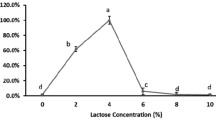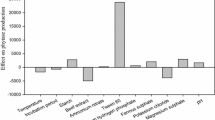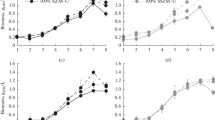Abstract
The present article deals with the studies on the effect of media ingredients, such as carbon, nitrogen, inorganic phosphates, surfactants, and metal salts, on phytase enzyme production by Aspergillus niger CFR 335 in submerged (SmF) and solid-state fermentations (SSF). The results obtained showed a 1.5-fold higher enzyme yield in the presence of sucrose in both SmF and SSF, while peptone was found to be a favorable nitrogen source for SmF. Sodium dihydrogen phosphate (NaH2PO4) favored 34% higher enzyme yield than the control, which was followed by 19% higher activity in potassium dihydrogen phosphate (KH2PO4) in SSF at 0.015% w/v. The addition of Tween-20 in SmF showed a maximum yield of 12.6 U/mL while, SDS suppressed the growth of the fungus. None of the surfactants favored the enzyme yield in SSF. Calcium chloride (CaCl2) was extensively efficient in stimulating more than 55% higher phytase production in SmF at 0.01% v/v. In SSF, none of the metal salts stimulated phytase production.






Similar content being viewed by others
References
Abelson PH (1999) A potential phosphate crisis. Science 283:2015. doi:10.1126/science.283.5410.2015
Al-Asheh S, Duvnjak Z (1994) The effect of surfactants of the phytase production and the reduction of the phytic acid content in canola meal by Aspergillus carbonarius during a solid state fermentation process. Biotechnol Lett 16:183–188. doi:10.1007/BF01021668
Al-Asheh S, Duvnjak Z (1995) The effect of phosphate concentration on phytase production and the reduction of phytic acid content in canola meal by Aspergillus carbonarius during a solid-state fermentation process. Appl Microbiol Biotechnol 43:25–30. doi:10.1007/BF00170617
Anne C, Walsh G (2004) Identification and characterization of a phytase of potential commercial interest. J Biotechnol 110(3):313–322. doi:10.1016/j.jbiotec.2004.03.001
Bogar B, Szakacs G, Linden JC, Pandey A, Tengerdy RP (2003) Optimization of phytase production by solid substrate fermentation. J Ind Microbiol Biotechnol 30:183–189
Bradford MM (1976) A rapid and sensitive method for the quantitation of microgram quantities of protein utilizing the principal of protein dye binding. Anal Biochem 72:248–254. doi:10.1016/0003-2697(76)90527-3
Ebune A, Alasheh S, Duvnjak Z (1995) Production of phytase during solid state fermentation using Aspergillus ficuum NRRL 3135 in canola meal. Bioresour Technol 53(1):7–12. doi:10.1016/0960-8524(95)00041-C
Fredrikson M, Andlid T, Haikara A, Sandberg AS (2002) Phytate degradation by micro-organisms in synthetic media and pea flour. J Appl Microbiol 93:197–204. doi:10.1046/j.1365-2672.2002.01676.x
Gargova S, Sariyska M (2003) Effect of culture conditions on the biosynthesis of Aspergillus niger phytase and acid phosphatase. Enzyme Microb Technol 32:231–235. doi:10.1016/S0141-0229(02)00247-8
Gibson DM (1987) Production of extracellular phytase from Aspergillus ficuum on starch media. Biotechnol Lett 9:305–310. doi:10.1007/BF01025793
Greiner R, Konietzny U, Jany KD (1993) Purification and characterization of two phytases from Escherichia coli. Arch Biochem Biophys 303:107–113. doi:10.1006/abbi.1993.1261
Gulati HK, Chadha BS, Saini HS (2007) Production, purification and characterization of thermostable phytase from thermophilic fungus Thermomyces lanuginosus TL-7. Acta Microbiol Immunol Hung 54:121–138. doi:10.1556/AMicr.54.2007.2.3
Gunashree BS, Venkateswaran G, Jagannatha RR (2007) Efficacy of Aspergillus niger phytase on the availability of phytate phosphorus. Int J Poult Sci 2(3):251–256
Han YW, Gallagher DJ (1987) Phosphatase production by Aspergillus ficuum. J Ind Microbiol 1:295–301. doi:10.1007/BF01569307
Heinonen JK, Lahti RJ (1981) A new and convenient colorimetric determination of inorganic orthophosphate and its application to the assay of inorganic pyrophosphatase. Anal Biochem 113:313–317. doi:10.1016/0003-2697(81)90082-8
Holleman AF, Wiberg E (2001) Inorganic chemistry. Academic Press, San Diego. ISBN 0-12-352651-352655
Howson SJ, Davis RP (1983) Production of phytate-hydrolyzing enzyme by some fungi. Enzyme Microb Technol 5:377–382. doi:10.1016/0141-0229(83)90012-1
Jareonkitmongkol S, Ohya M, Watanabe R, Takagi H, Nakamori S (1997) Partial purification of phytase from a soil isolate bacterium, Klebsiella oxytoca MO-3. J Ferment Bioeng 83(4):393–394. doi:10.1016/S0922-338X(97)80149-3
Jeri WN (2005) Osteoporosis: the role of micronutrients. Am J Clin Nutr 81:1232–1239
Kerovuo J, Lappalainen I, Reinikainen T (2000) The Metal dependence of Bacillus subtilis phytase. Biochem Biophys Res Commun 268(2):365–369. doi:10.1006/bbrc.2000.2131
Kerovuo J, Lauraeus M, Nurminen P, Kalkkinen N, Apajalahti J (1998) Isolation, characterization, molecular gene cloning and sequencing of a novel phytase from Bacillus subtilis. Appl Environ Microbiol 64:2079–2085
Kim DS, Godber JS, Kim HR (1999) Culture conditions for a new phytase producing fungus. Biotechnol Lett 21:1077–1081. doi:10.1023/A:1005696829168
Krishna C, Nokes SE (2001) Predicting vegetative inoculum performance to maximize phytase production in solid-state fermentation using response surface methodology. J Ind Microbiol Biotechnol 26:161–170. doi:10.1038/sj.jim.7000103
Krishnan R, Sumitra R, Nampoothiri KM, George S, Pandey A (2006) Comparison of phytase production on wheat bran and oilcakes in solid-state fermentation by Mucor racemosus. Bioresour Technol 97:506–511. doi:10.1016/j.biortech.2005.02.046
Lambrechts C, Boze H, Segueilha L, Moulin G, Galzy P (1993) Influence of culture conditions on the biosynthesis of Schwanniomyces castellii phytase. Biotechnol Lett 15:399–404. doi:10.1007/BF00128284
Lambrechts C, Boze H, Segueilha L, Moulin G, Galzy P (1992) Utilization of phytate by some yeasts. Biotechnol Lett 14:61–66. doi:10.1007/BF01030915
Lei XG, Porres JM (2003) Phytase enzymology, applications, and biotechnology. Biotechnol Lett 25:1787–1794. doi:10.1023/A:1026224101580
Mallin MA (2000) Impacts of industrial animal production on rivers and estuaries. Am Sci 88:26–37
Manary MJ, Krebs NF, Gibson RS, Broadhead RL, Hambridge KM (2002) Community-based dietary phytate reduction and its effect on iron status in Malawian children. Ann Trop Paediatr 22:133–136. doi:10.1179/027249302125000850
Mandviwala TN, Khire JM (2000) Production of high activity thermostable phytase from thermotolerant phytase from thermotolerant Aspergillus niger in solid state fermentation. J Ind Microbiol Biotechnol 24:237–243. doi:10.1038/sj.jim.2900811
Mullaney EJ, Daly C, Ullah AB (2000) Advances in phytase research. Adv Appl Microbiol 47:157–199. doi:10.1016/S0065-2164(00)47004-8
Nakamura Y, Fukuhara H, Sano L (2000) Secreted phytase activities of yeasts. Biosci Biotechnol Biochem 64:841–844. doi:10.1271/bbb.64.841
Nampoothiri KM, Tomes GJ, Krishnan R, Szakacs G, Nagy V, Soccol CR et al (2004) Thermostable phytase production by Thermoascus aurantiacus in submerged fermentation. Appl Biochem Biotechnol 118:205–214. doi:10.1385/ABAB:118:1-3:205
Naqvi SWA, Jayakumar DA, Narvekar PV, Naik H, Sarma VVSS, D’Souza W et al (2000) Increased marine production of N2O due to intensifying anoxia on the Indian continental shelf. Nature 408:346–349. doi:10.1038/35042551
Ostanin K, van Etten RL (1993) Asp304 of Escherichia coli acid phosphatase is involved in leaving group protonation. J Biol Chem 268:20778–20784
Pagano AR, Yasuda K, Roneker KR, Crenshaw TD, Lei XG (2007) Supplemental Escherichia coli phytase and strontium enhance bone strength of young pigs fed a phosphorus-adequate diet. J Nutr 137:1795–1801
Pasamontes L, Haiker M, Wyss M, Tessier M, van Loon APGM (1997) Gene cloning, purification and characterization of a heat stable phytase from the fungus Aspergillus fumigatus. Appl Environ Microbiol 63:1696–1700
Piddington CS, Houston CS, Paloheimo M, Cantrell M, Miettinen- Oinonen A, Nevalanien H et al (1993) The cloning and sequencing of the genes encoding phytase (phy) and pH 25 optimum acid phosphatase (aph) from Aspergillus niger var. awamori. Gene 133:55–62. doi:10.1016/0378-1119(93)90224-Q
Pinky G, Sabu A, Pandey A, Szakacs G, Soccol CR (2002) Microbial production of extra-cellular phytase using polystyrene as inert solid support. Bioresour Technol 83(3):229–233. doi:10.1016/S0960-8524(01)00215-2
Powar VK, Jagannathan V (1982) Purification and properties of phytate-specific phosphatase from Bacillus subtilis. J Bacteriol 151(3):1102–1108
Robert PH, Nordin BEC (2002) Calcium effects on phosphorus absorption: implications for the prevention and co-therapy of osteoporosis. J Am Coll Nutr 21:239–244
Sabu A, Sarita S, Pandey A, Bogar B, Szakacs G, Soccol CR (2002) Solid-state fermentation for production of phytase by Rhizopus oligosporus. Appl Biochem Biotechnol 102:251–260. doi:10.1385/ABAB:102-103:1-6:251
Schroder B, Breves G, Rodehutscord M (1996) Mechanisms of intestinal phosphorus absorption and availability of dietary phosphorus in pigs. Dtsch Tierarztl Wochenschr 103:209–214
Sen BH, Akdeniz G, Denizci A (2000) The effect of ethylenediamine-tetraacetic acid on Candida albicans. Oral Surg Oral Med Oral Pathol Oral Radiol Endod 90:651–655. doi:10.1067/moe.2000.109640
Shimizu M (1992) Purification and characterization of phytase from Bacillus subtilis (natto) N-77. Biosci Biotechnol Biochem 56:1266–1269
Snedecor GW, Cochran WG (1976) Statistical methods, 6th edn. Iowa State University Press, Ames, pp 258–298
Sunitha K, Lee JK, Oh TK (1999) Optimization of medium components for phytase production by E-coli using response surface methodology. Bioprocess Eng 21(6):477–481
Takanobu H (2002) Novel functions and applications of trehalose. Pure Appl Chem 74:1263–1269. doi:10.1351/pac200274071263
Ullah AHJ, Dischinger HC (1993) Aspergillus ficuum phytase: complete primary structure elucidation by chemical sequencing. Biochem Biophys Res Commun 192:747–753. doi:10.1006/bbrc.1993.1477
Ullah AHJ, Phillippy BQ (1994) Substrate selectivity in Aspergillus ficuum phytase and acid phosphatases using myo-inositol phosphates. J Agric Food Chem 42:423–425. doi:10.1021/jf00038a034
Vats P, Banerjee UC (2002) Studies on the production of phytase by a newly isolated strain of Aspergillus niger var teigham obtained from rotten wood-logs. Process Biochem 38:211–217. doi:10.1016/S0032-9592(02)00079-1
Vats P, Banerjee UC (2004) Production studies and catalytic properties of phytases (myo-inositol hexakis phosphate phosphor hydrolases): an overview. Enzyme Microb Technol 35:3–14. doi:10.1016/j.enzmictec.2004.03.010
Vohra A, Satyanarayana T (2001) Phytase production by the yeast, Pichia anomala. Biotechnol Lett 23(7):551–554. doi:10.1023/A:1010314114053
Vohra A, Satyanarayana T (2003) Phytases: Microbial sources, production, purification, and potential biotechnological applications. Crit Rev Biotechnol 23(1):29–60. doi:10.1080/713609297
Wang C, Eufemi M, Turano C, Giartosio A (1996) Influence of the carbohydrate moiety on the stability of glycoproteins. Biochemistry 35:7299–7307. doi:10.1021/bi9517704
Wei GX, Bobek LA (2005) Human salivary mucin MUC7 12-Mer-l and 12-Mer-d peptides: antifungal activity in saliva, enhancement of activity with protease inhibitor cocktail or EDTA, and cytotoxicity to human cells. Antimicrob Agents Chemother 49:2336–2342. doi:10.1128/AAC.49.6.2336-2342.2005
Wodzinski RJ, Ullah AHJ (1996) Phytase. Adv Appl Microbiol 42:263–303. doi:10.1016/S0065-2164(08)70375-7
Wodzinski RJ, Panchal T (1998) Comparison of glycosylation patterns of phytase from Aspergillus niger (A. ficuum) NRRL and recombinant phytase. Prep Biochem Biotechnol 28:201–217. doi:10.1080/10826069808010136
Wyss M, Brugger R, Kronenberger A, Remy R, Fimbel R, Oesterhelt G et al (1999) Biochemical characterization of fungal phytases (myo-inositol hexakisphosphate phosphohydrolases): catalytic properties. Appl Environ Microbiol 65:367–373
Yano F, Nakajima T, Matsuda M (1999) Reduction of nitrogen and phosphorus from livestock waste: a major priority for intensive animal production. Asian-australas J Anim Sci 12:651–656
Acknowledgments
Authors are thankful to the Director, Central Food Technological Research Institute, Head, Food Microbiology Department, for his constant support and encouragement to carry out this research and University of Mysore for the financial aid.
Author information
Authors and Affiliations
Corresponding author
Rights and permissions
About this article
Cite this article
Gunashree, B.S., Venkateswaran, G. Effect of different cultural conditions for phytase production by Aspergillus niger CFR 335 in submerged and solid-state fermentations. J Ind Microbiol Biotechnol 35, 1587–1596 (2008). https://doi.org/10.1007/s10295-008-0402-1
Received:
Accepted:
Published:
Issue Date:
DOI: https://doi.org/10.1007/s10295-008-0402-1




